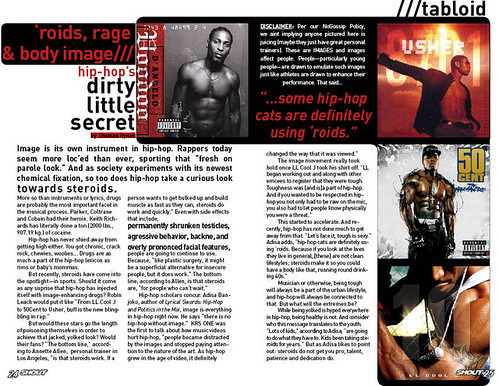Hip Hop's Dirty Little Secret

By Thomas Hynes
Image is its own instrument in hip-hop. Rappers today seem more loc'ed than ever, sporting that "fresh on parole look." And as society experiments with its newest chemical fixation, so too does hip-hop take a curious look towards steroids.
Like instruments or lyrics, drugs are an important facet in the musical process. Parker, Coltrane and Cobain had their heroin. Keith Richards has literally done a ton (2000 lbs., 907.19 kg.) of cocaine. You have to fail a urinalysis to even get signed at some labels.
Hip-hop has never shied away from getting high either. You got chronic, crack rock, hare-ron, blunts, chewies, woolies... Drugs are as much a part of the hip-hop lexicon as rims or baby-mammas.
Recently, steroids have come into the spotlight—in sports. Should it come as a surprise that hip-hop has also injected itself with image-enhancing drugs? Robin Leach would put it like "From LL Cool J to 50Cent to Usher, buff is the new bling-bling in rap."
Would hip-hop stars go the length some athletes have by poisoning themselves in order to achieve that jacked, yolked look? "The bottom line," according to Annette Allen, personal trainer to the stars, "is that steroids work. If a person wants to get bulked up and build muscle as fast as they can, steroids do work and quickly." Even with side effects that include permanently shrunken testicles, aggressive behavior, "backne," and man-boobs, people are going to continue to use. Because Allen says, "like plastic surgery, it might be a superficial alternative, but it does work. The bottom line is that steroids are for people who can't wait."
Hip-hop scholars concur. Adisa Banjoko, author of Lyrical Swords: Hip-Hop and Politics in the Mix, image is everything in hip-hop right now. He says "there is no hip-hop without image. KRS ONE was the first to talk about how music videos hurt hip-hop because people became distracted by the images and stopped paying attention to the nature of the art. As hip-hop grew in the age of video, it definitely changed the way that it was viewed."
The image movement really took hold once LL Cool J took his shirt off. "LL began working out and along with other emcees to register that they were tough. Toughness was [and is] a part of hip-hop. And if you wanted respect in hip-hop you not only had to be raw on the mic, you also had to let people know physically you were a threat."
This started to accelerate. And recently, hip-hop has not done much to get away from "image" and back on message. "Let's face it, tough is sexy." Adisa adds, "hip-hop cats are definitely using 'roids. Because if you look at the lives they live in general, [these] are not clean lifestyles; steroids make it so you could have a body like that, running round drinking 40s."
Musician or otherwise, being tough will always be a part of the urban lifestyle, and hip-hop will always be connected to that. But what will the extremes be? While being yolked is hyped everywhere in hip-hop, being healthy is not. And consider who this message translates to the youth. "Lots of kids," according to Adisa, "are going to do what they have to. Kids been taking steroids for years." But as Adisa likes to point out: steroids do not get you pro: talent, patience and dedication do.


<< Home